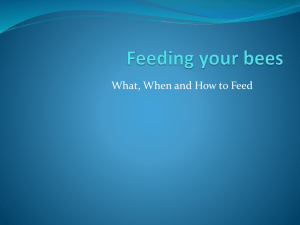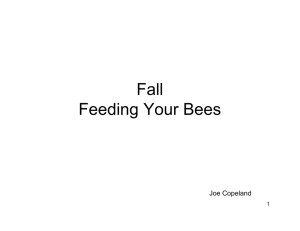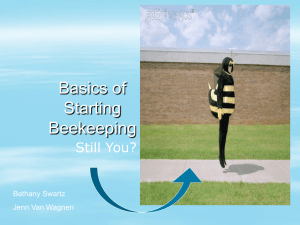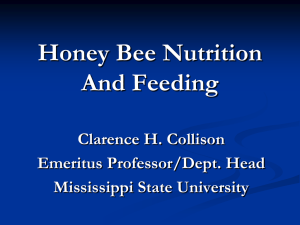Bee Brew and Such - Loudoun Beekeepers Association
advertisement
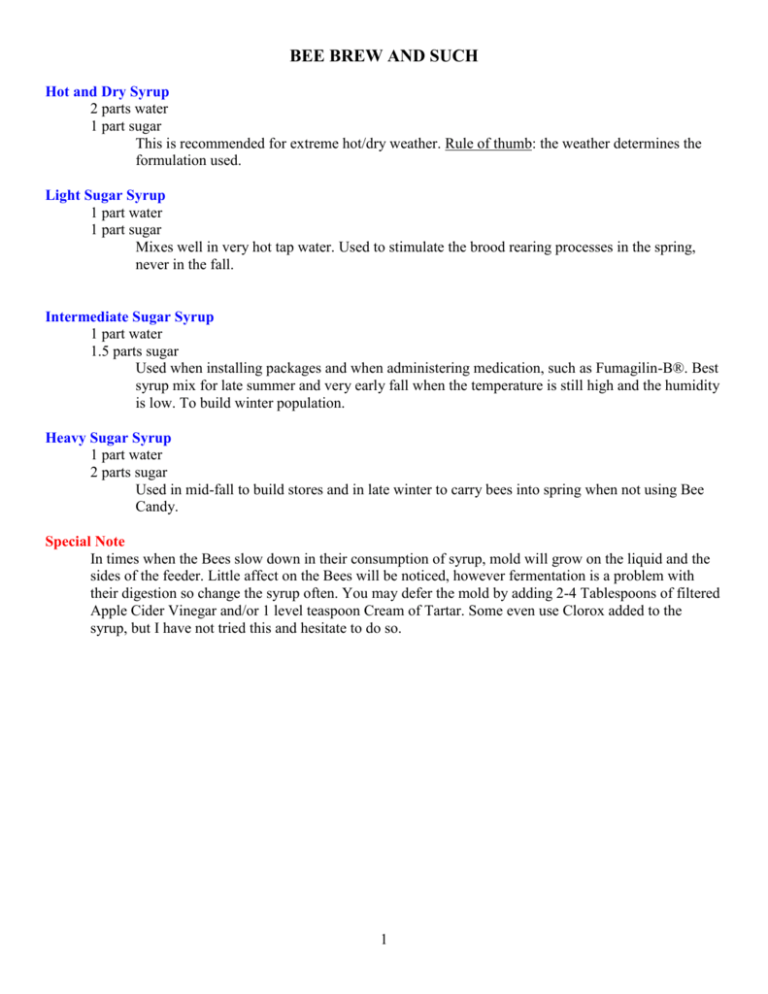
BEE BREW AND SUCH Hot and Dry Syrup 2 parts water 1 part sugar This is recommended for extreme hot/dry weather. Rule of thumb: the weather determines the formulation used. Light Sugar Syrup 1 part water 1 part sugar Mixes well in very hot tap water. Used to stimulate the brood rearing processes in the spring, never in the fall. Intermediate Sugar Syrup 1 part water 1.5 parts sugar Used when installing packages and when administering medication, such as Fumagilin-B®. Best syrup mix for late summer and very early fall when the temperature is still high and the humidity is low. To build winter population. Heavy Sugar Syrup 1 part water 2 parts sugar Used in mid-fall to build stores and in late winter to carry bees into spring when not using Bee Candy. Special Note In times when the Bees slow down in their consumption of syrup, mold will grow on the liquid and the sides of the feeder. Little affect on the Bees will be noticed, however fermentation is a problem with their digestion so change the syrup often. You may defer the mold by adding 2-4 Tablespoons of filtered Apple Cider Vinegar and/or 1 level teaspoon Cream of Tartar. Some even use Clorox added to the syrup, but I have not tried this and hesitate to do so. 1 Bee Candy (A) “The Hive and the Honeybee” 15 lbs sugar 3 lbs corn syrup (3 pints) 4 cups water 1/2 teaspoon Cream of Tartar Dissolve sugar and Cream of Tartar in hot water. Heat to 242 degrees F on a candy thermometer. Stir as temperature goes up. Remove from heat and continue stirring while cooling to 180 degrees F. Then begin to beat the mix until it begins to harden. Pour in molds or on wax paper so each cake is about 2 lbs and about 1/2-inch thick. (Move rapidly as this mix sets quickly.) Place the candy on the top bars directly in the path (thermal column) the bees follow in the winter movement upward. Use a 2” shim or an empty shallow or medium hive body. Place a sheet of newspaper over the candy to draw moisture to the candy softening it for the bees. Replace the inner cover and telescoping cover. There are many versions of this process. Try different mixes and settle with the one the bees process readily, and pay no attention to the beekeeper’s comfort or ease in processing. There are many that have success with using the cheap paper plates as forms. Remember, candy must be solid, opaque in color and not sticky at room temperature when done. Bee Candy (B) 10 lbs sugar 3.5 cups water 3.5 teaspoons white vinegar Mix the vinegar and water bringing them up to boil with the cover on the pot, then slowly add sugar stirring until dissolved and re-cover. Continue to stir occasionally and re-cover until the brew comes to a boil. Keep the lid on for a few minutes to run the condensate down the sides. Note: Replacing the lid will become important when doing consecutive batches as it helps prevent caking on the sides. The temperature will reach the desired 242 degrees F when enough water has boiled away. Take whole pot, sit it in cold water in sink and whip/stir vigorously. Careful—this stuff is hot! When temp gets down to 200–210 degrees F start the pour. Do not waste time as the set starts at higher temp in this mix than the one above. The second batch can quickly follow by putting the water and vinegar in the same pot and bring to a rolling boil with the lid in place so the crusted sugar will wash down. Then slowly add the sugar. Hints: I use a pot with glass top so I can keep tabs on the brew to avoid a boil over. I use a Turkey-Fry thermometer that is a dial with an extra long probe. I run the temperature up to 242 degrees F. I have many batches to do so I do not clean up the pot until I have completed the season. Keep any sugar off the outside of the pot. 2 Bee Candy (C) – SHP No Cook Sugar Brick 10 pounds cane sugar 1 cup water 1 teaspoon white vinegar Mix thoroughly, until it will hold its ball character. DO NOT BE TEMPTED TO ADD MORE LIQUID. Pack into a form (shim) approximately 2 inches deep. It will be fitted over the top hive body with the inner cover placed on top of the shim. Inner covers that have ventilation holes in them must have a block of wood, such as a short piece of 2 x 4 covering the vent area. It is advised to imbed a small patty of pollen substitute in the candy. Keep the patty small to avoid a beetle problem. The whole thing is to set overnight, but remove the blocks soon after the shim is packed. 3 GREASE PATTIES FOR TRACHEAL MITE CONTROL Solidified vegetable shortening (like Crisco®) mixed with granulated white sugar to the consistency of greasy dough patties, i.e., it will stay together and not crumble. Ratio of 2 parts sugar to 1 part grease. Put hamburger-size patty on piece of wax paper. Place the patty on the top bars near the brood cluster. Note: Yards located in areas infested by the small hive beetle should not have grease patties. Beetles feed on them. FEEDERS 1. Boardman: Designed to fit in the entrance. Do not use this feeder in the chilly spring or in the fall as a front entry feeder. Bees will not leave the cluster to go down to get syrup. Great for feeding water during periods of drought. Could lead to robbing if used during mid-summer through late summer, during dearth periods. 2. Baggie: Recommended when installing packages. It is easy, inexpensive and provides some insulation for the new queen. Use heavy-duty 1-gallon freezer bags. Fill with 1/2 gallon of liquid. Place two of the bags on the top bars of the top box with the top of the bags facing each other in the center of the box. In my recommended queen-cage placement the front bag covers the cage. Properly done this will not block the queen and the feeding screen is in the open between two frames. ‘With no comb normally in a beginners boxes this is and easy, sure fire way to introduce the queen. 3. Pail: These are available commercially. They have a stainless steel screen through which the bees feed when the pail is inverted over the top bars or the escape hole in the inner cover. These pails are available in 1- to 3-gallon sizes. It is best to protect them with an empty box. I have used them but I do not list them on my preferred list. 4. Jug or Jar: Several configurations are found depending on the beekeeper’s need. When I had commercial pollination hives I fed with a 1-gallon jug inverted into the top cover. The lid of the jug was modified either by punching about six 1/16-inch holes from the inside of the lid very close to the center of the lid in an area about the size of a dime. One can use a large-mouth gallon jug inverted over the inner cover with holes of the same configuration as above. (NEVER USE PLASTIC JARS; they collapse.) 4 5. Hive Top: These come in all sort of configurations. (NOTE: The hive must be level.) Be sure there is a way for the bees to get to the syrup without drowning and that they are confined to the feeding entry and not the whole top of the feeder. If the bees have entry to the reservoirs of the feeder one may staple nylon screen to the top of the floats covering the float and the syrup area totally. The bees will feed through the screen and not fall in. 6. BeeMax® Hive Top Feeder: Very good feeder as the bees are not exposed to the outside air and can be seen feeding when the conventional hive top units have no activity. Care must be taken to prevent the mold to which these feeders are very susceptible. We plan to utilize more of this large feeder where needed. 7. Division Board Feeder: This unit replaces one of the frames in the hive. Generally there is a float or screen to help keep bees out of the syrup. It is necessary to open the hive to feed therefore is objectionable to some Beekeepers. 8. Thorne Rapid Feeder: This is my personal favorite. The unit resembles a small bunt pan with an enter cone cover and a reservoir cover. Very few bees drown in this feeder as it sits over the escape hole of the inner cover where the maximum internal colony heat is located therefore the bees are very agile and even when getting wet, crawl out and are cleaned immediately. It holds only one/half gallon and must be serviced quite often. Note: If you find a lot of dead bees in this feeder, my experience is these are robbers and the colony is in serious trouble or doomed. 9. Group Feeder: There are those that recommend this system of providing an open feeder for all the bees in the yard and/or the neighborhood to help themselves. Yes, I am as lazy as the next Beekeeper. I have tried several configurations and none of them worked without losing thousands of my girls or setting up a mass robbing frenzy. Never do this during a dearth. Group feeding is risky under any circumstances as robbing can be a real problem and if the feeders get empty, guess where they rob; right, your weaker colonies. 5 POLLEN SUPPLIMENTS --- POLLEN SUBSTITUTES A pollen substitute contains various ingredients to be a substitute for natural pollen. A pollen supplement contains natural pollen as an ingredient. Supplement formulas are numerous, therefore I recommend beginners use pollen substitutes until pollen is available from flowers. Premixed and packed substitute is available from bee supply companies. Pollen substitutes come in powder or patty form. Dadant carries the new MegaBee (The Tucson Bee Diet) that is probably the best on the market today. It is possible to mix your own pollen supplement using this recipe. The pollen must come from your own bees and stored properly to avoid disease and contamination. One cake: 2 ounces pollen collected from your own hives Or 1 ounce Brewer’s yeast and 1 ounce powdered skim milk 6 ounces food-grade soy flour 5-1/2 ounces water 10-1/2 ounces sugar Heat the water and dissolve the sugar, forming a heavy syrup. A 50-50 mix: pollen + pollen substitute is recommended. Mix the powders with equal parts pollen from your own healthy pollen-gathering colonies. Then add the heavy syrup to make a heavy dough consistency. Feed a glob (about 1/2-1 pound on the top bars over the cluster. Do not feed commercially obtained pollen as it could potentially carry AFB. Large quantities? You do the math. 6 Mite Boards 1. The best around is the computer-generated board developed at Penn State University. It has a random pattern of blacked-out areas, thus only the clear areas are counted. There was no delivery frame developed and one must create a screen covering if using a solid bottom board. Tanglefoot® is the compound used to entrap the mites. This will not entrap the small hive beetle, but it sticks to everything else, including beekeepers. 2 Another is a sticky board with a simple grid imprinted on the board to use as an aid in counting. It is provided with a vinyl-coated cover resembling stretched metal. Small sticks are used as spacers to keep the bees off the board and to prevent the bees from cleaning off the board. Tanglefoot is the sticking agent. 3. A sheet of white corrugated plastic or white, hard fiberboard on which one sprays PAM is advised. This is a practical board and makes mite counting in the field much easier, especially if one uses a shallow shim wired into quadrants reducing the area of concentration. Comment: Both methods require space between sticky board and a screen. Since we advocate the use of screen bottom boards the simple conclusion is combine. Thus the Screen Bottom Board has a built in provision for inserting a mite board or closure board. Both 1. and 2. sticky boards can be wrapped with Saran Wrap® and preserved. Reading the bottom board is not a joke but with practice the beekeeper can develop the ability to detect changes with the colony and conditions within the colony. Just a sample: detecting dysentery in its early stage in late winter or early spring when the board is in place for a longer period. One can detect when the major spring brood rearing is underway. International Queen Colors Blue is for years ending in White “ “ “ “ “ Yellow “ “ “ “ “ Red “ “ “ “ “ Green “ “ “ “ 0 or 5 1 or 6 2 or 7 3 or 8 4 or 9 7 Chubby Bees Oil This is my recipe based on the research I found at online at West Virginia University. Please don't refer to it by any commercial name. I use it mixed with sugar syrup as a feed supplement/stimulate and hopefully it will contribute as a miticide. This recipe makes 1 quart - I use a 1 quart mason jar. To obtain the essential oils, I use www.bulkapothecary.com. They have a very wide selection of oils from different countries. If you look to other sources online such as Amazon make sure you know the genus and species of the plant for Lemongrass and Spearmint to ensure they are really selling what you want. Bulk Apothecary also sells Sodium Lauryl Sulfate but there are other sources for smaller quantities online. As an emulsifier I use xanthan gum which is a little pricy but is available in Harris Teeter or Wegmans in the baking aisle. You can also use Lethicin granules also available for baking. However do not simply buy Lethicin capsules at GNC. The gelatin capsule shell makes a mess. 1/6th of a cup = 1.33 fluid ounces so if you decide to buy 1 ounce bottles of essential oils you may need to adjust the recipe. Do not use the measuring cups or spoons from your kitchen for essential oils. The aroma will never come out and human internal consumption of these product is toxic. If you want to do this get your own stuff for bee keeping! Ingredients: • Spearmint Oil – 1/6 Cup • Lemongrass oil – 1/6 Cup • Water – 3.5 Cups • *Xanthan Gum – 2 tsp Or • *Lethicin granules - 2 tsp • Sodium Laural Sulfate - 1 TBs Instructions: Fill a 1 quart sealable mason jar or equivalent with 3 cups of water. You will need headspace to shake the jar for mixing. Add both essential oils Add 2 teaspoons of xanthan gum or lethicin. Seal jar and shake vigorously. You should have a cream colored viscous liquid. If you added too much xanthan gum or lethicin it will be floating in the oil - like extra flour when you make gravy. Don't worry it won't hurt the bees. Open the jar and add the sodium laural sulfate AND the 1/2 cup of water that will fill the jar to a full quart. Shake to mix. You're done. 8 To use: Do not use this oil straight on your bees. Use at a ratio of 2 teaspoons per quart of 1:1 sugar syrup when you feed your bees. Maintain this ratio as you make bigger batches of syrup. 8 teaspoons per gallon. Good luck, Frank Ludlow 9


